Not in NCERT)"
| Table of contents |

|
| Introduction |

|
| Morphology of Cockroach |

|
| Anatomy of Cockroach |

|
| Digestive System |

|
| Respiratory System |

|
| Nervous System |

|
| Sense Organs |

|
| Excretory System |

|
| Reproductive System |

|
Introduction
- Cockroaches are insects that belong to the class Insecta within the phylum Arthropoda.
- They are typically brown or black, but in tropical regions, brightly colored cockroaches in yellow, red, and green have been observed.
- Their size can range from about ¼ inch to 3 inches(0.6 to 7.6 cm).
- Cockroaches have long antennae, legs, and a flat extension of their upper body wall that covers their head.
- These insects are nocturnal omnivores, meaning they are active at night and eat a variety of foods. They prefer damp environments and are found all over the world.
- Cockroaches have adapted to living in human homes, making them serious pests and potential vectors for various diseases.
Morphology of Cockroach
Male common household cockroaches typically measure between 34 to 53 mm in length, with wings that extend past the abdomen. Their entire body is covered by a tough exoskeleton made of chitin. In terms of morphology, the cockroach's body is segmented into three parts: the head, abdomen, and thorax.
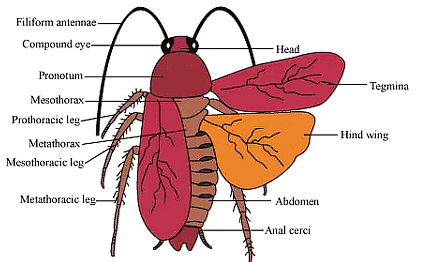
Head
- Shape and Orientation: The head is triangular and positioned at a right angle to the body axis, allowing for flexibility.
- Segmentation and Mobility: It is formed by the fusion of six segments, providing great mobility in all directions due to a flexible neck.
- Compound Eyes: The head capsule features a pair of compound eyes for enhanced vision.
- Antennae: A pair of thread-like antennae, equipped with sensory receptors, arises from membranous sockets in front of the eyes. These antennae help monitor the environment.
- Mouthparts: The anterior end of the head has appendages that form biting and chewing mouthparts, including a labrum (upper lip), a pair of mandibles, a pair of maxillae, and a labium (lower lip).
- Hypopharynx: A median flexible lobe, acting as a tongue (hypopharynx), is located within the cavity enclosed by the mouthparts.
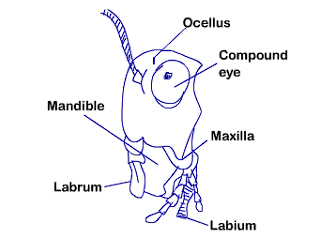 Head of Cockroach
Head of Cockroach
Thorax
The thorax is divided into three parts: prothorax, mesothorax, and metathorax.
- The head is connected to the thorax by a short extension of the prothorax called the neck.
- Each segment of the thorax has a pair of walking legs.
- The first pair of wings comes from the mesothorax, and the second pair comes from the metathorax.
- Forewings, also known as tegmina, are found on the mesothorax. They are opaque, dark, and leathery, covering the hind wings when the insect is at rest.
- Hind wings are transparent, membranous, and are used for flight.

Abdomen
Segments: Both males and females have 10 segments in their abdomen.
Females: The 7th sternum is boat-shaped. The 7th, 8th, and 9th sterna form a brood or genital pouch. This pouch contains:
- Female gonopore
- Spermathecal pores
- Collateral glands
Males: The genital pouch is located at the hind end of the abdomen. It is bounded dorsally by the 9th and 10th terga and ventrally by the 9th sternum. The pouch contains:
- Dorsal anus
- Ventral male genital pore
- Gonapophysis
- Anal Styles: Males have a pair of short, threadlike anal styles, which are absent in females. Anal Cerci: Both sexes have a pair of jointed filamentous structures called anal cerci on the 10th segment.
Anatomy of Cockroach
The anatomy of a cockroach is as follows:
Digestive System
Alimentary canal is divided into foregut, midgut, and hindgut.
Foregut:
- Mouth opens into a short tubular pharynx, leading to a narrow passage called oesophagus.
- Oesophagus opens into a sac-like structure called crop for food storage.
- Crop is followed by the gizzard or proventriculus, which has:
- Thick circular muscles and a thick inner cuticle.
- Six chitinous plates called teeth for grinding food.
- The entire foregut is lined by cuticle.
- At the junction of foregut and midgut, there are 6-8 blind tubules called hepatic or gastric caeca that secrete digestive juice.
Midgut: At the junction of midgut and hindgut, there is a ring of 100-150 yellow, thin, filamentous Malpighian tubules that help remove excretory products from haemolymph.
Hindgut: Broadly differentiated into ileum,colon, and rectum. Rectum opens out through the anus.
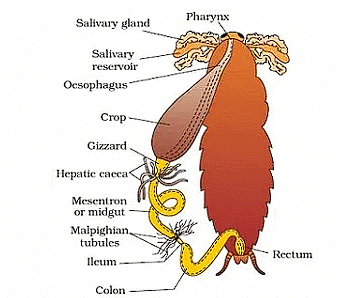 Alimentary canal of cockroach
Alimentary canal of cockroach
Blood Vascular System
- The blood vascular system in cockroaches is of the open type.
- Blood vessels are not well-developed and open into a body space called the haemocoel.
- Visceral organs located in the haemocoel are surrounded by blood, known as haemolymph.
- Haemolymph is made up of colourless plasma and cells called haemocytes.
- The heart of the cockroach is an elongated muscular tube situated along the mid-dorsal line of the thorax and abdomen.
- The heart is differentiated into funnel-shaped chambers with openings called ostia on either side.
- Blood from the sinuses enters the heart through the ostia and is pumped anteriorly back to the sinuses.
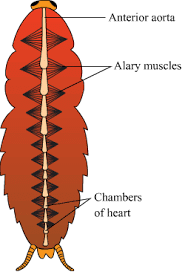 Open circulatory system of cockroach
Open circulatory system of cockroachRespiratory System
The respiratory system of cockroaches comprises a network of trachea present on the lateral side of the body. The trachea consists of 10 pairs of small holes called spiracles. Thin branching tubes also known as tracheal tubes which are further subdivided into tracheoles supply oxygen to all the parts of the body. Tracheoles is the location for the exchange of gases by diffusion.
Nervous System
Structure of Nervous System in Cockroach
- The nervous system of the cockroach consists of a series of segmentally arranged ganglia that are fused together.
- These ganglia are connected by paired longitudinal connectives and are located on the ventral side (belly side) of the body.
- There are three ganglia in the thorax and six ganglia in the abdomen.
- The nervous system is spread throughout the body, with a portion in the head and the rest along the ventral side.
- The head contains the supra-oesophageal ganglion, which acts as the brain and supplies nerves to the antennae and compound eyes.
- The rest of the nervous system runs along the ventral side of the body.
Ganglia
- Ganglia are clusters of nerve cells that act as processing centers for information in the nervous system.
- In cockroaches, these ganglia are responsible for coordinating various body functions, including movement and sensory processing.
Function of Nervous System in Cockroach
- Even if the head of a cockroach is cut off, it can survive for up to a week because the nervous system is still functioning.
- The nervous system controls all voluntary and involuntary actions of the cockroach.
Sense Organs
- Antennae: Used for sensing odors and vibrations.
- Compound Eyes: Located on the dorsal (top) surface of the head, each eye is made up of about 2000 hexagonal units called ommatidia. This allows the cockroach to see multiple images of an object at once, a type of vision known as mosaic vision. This vision is more sensitive but has lower resolution, making it useful for seeing in the dark (nocturnal vision).
- Maxillary Palps: Help in tasting and feeling food.
- Labial Palps: Similar to maxillary palps, they help in tasting and feeling food.
- Anal Cerci: Located at the rear end, these are used for sensing air movements and vibrations.
Compound Eyes
- The compound eyes of a cockroach are made up of many individual ommatidia, each of which captures a small part of the image.
- The brain then combines these images to create a single picture, allowing the cockroach to see its surroundings effectively, especially in low light conditions.
Excretory System
The organic waste from the body is removed through Malpighian tubes. The glandular and ciliated cells absorb the nitrogenous waste and are present in the lining of each tubule. This nitrogenous waste is converted to uric acid and passes out through hindgut. Cockroaches are uricotelic.
Reproductive System
Introduction
Cockroaches are insects that can be found in various environments. They are known for their flat bodies, long antennae, and the ability to scuttle quickly. While some species are harmless, others are considered pests due to their potential to contaminate food and transmit diseases.
Reproductive System of Male Cockroaches
- Dioecious: Cockroaches have distinct male and female individuals.
- Male Reproductive Organs: Males possess a pair of testes located in the 4th to 6th abdominal segments.
- Sperm Transport: Sperm travels from the testes through the vas deferens, into the ejaculatory duct via the seminal vesicle.
- Gonopore: The ejaculatory duct opens into the male gonopore, located ventral to the anus.
- Accessory Gland: A mushroom-shaped gland in the 6th to 7th abdominal segments acts as an accessory reproductive gland.
- Spermatophores: Sperm is stored in the seminal vesicles and forms bundles called spermatophores, which are released during mating.
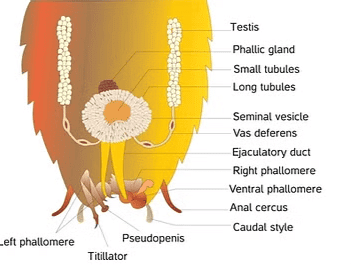 Reproductive System of Male Cockroach
Reproductive System of Male Cockroach
Reproductive System of Female Cockroaches
- Ovaries: Females have two large ovaries located in the 2nd to 6th abdominal segments, each made up of eight ovarioles containing developing eggs.
- Oviducts: The oviducts from each ovary merge into a single median oviduct (vagina) that opens into the genital chamber.
- Spermatheca: A pair of spermathecae in the 6th segment stores sperm and opens into the genital chamber.
- Egg Cases: Fertilized eggs are encased in oothecae, which are dark reddish to blackish brown capsules about 8 mm long.
- Egg Production: Females produce an average of 9-10 oothecae, each containing 14-16 eggs.
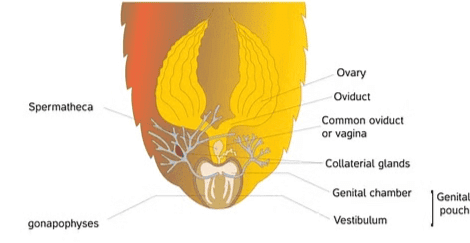 Reproductive System of Female Cockroach
Reproductive System of Female CockroachDevelopment
- Paurometabolous Development: Cockroaches undergo development through nymphal stages that resemble adults.
- Nymphal Growth: The nymph grows by molting approximately 13 times to reach the adult form.
- Wing Development: The penultimate nymphal stage has wing pads, but only adult cockroaches have fully developed wings.
Economic Importance
- Wild Species: Many cockroach species are found in the wild and do not have known economic significance.
- Pest Species: Some species thrive in human habitats and become pests by spoiling and contaminating food with their excreta.
- Disease Transmission: Cockroaches can transmit various bacterial diseases by contaminating food materials.
|
150 videos|398 docs|136 tests
|
FAQs on Not in NCERT)"
| 1. What is the external structure of a cockroach? |  |
| 2. How is the internal anatomy of a cockroach organized? |  |
| 3. What are the functions of the different organs in a cockroach's body? |  |
| 4. How does the morphology of a cockroach contribute to its adaptability and survival? |  |
| 5. How can an understanding of a cockroach's morphology and anatomy be beneficial for pest control? |  |





















